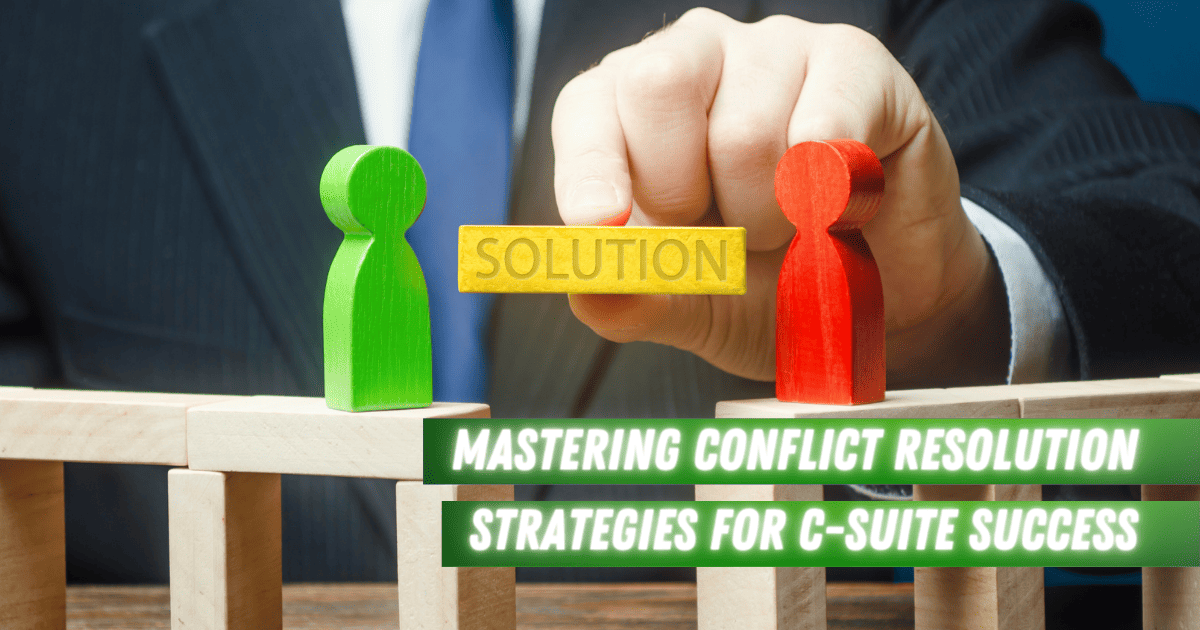In the fast-paced world of the C-suite, conflicts are not just inevitable; they’re practically a part of the job description. As an executive leadership coach, I’ve witnessed time and again how a leader’s ability to effectively manage and resolve conflicts can make or break their success. In this blog, we’ll delve into the essential Conflict Resolution Strategies for C-Suite Success. These insights will not only help you navigate the turbulent waters of leadership but also position you as an authority in the boardroom.
Understanding the Nature of Conflict
Conflict in the C-suite can stem from various sources, including differences in vision, strategy, personal values, or simply clashes in personalities. Some conflicts may even arise from external pressures, market challenges, or competitive forces. Recognizing that not all conflicts are negative is crucial. Healthy debates can lead to innovative solutions and improved decision-making. As an executive leader, your first task is to identify the underlying causes of conflicts and assess their potential impact on the organization. By distinguishing between healthy disagreement and destructive disputes, you can effectively allocate your energy and resources to address conflicts that truly matter.
Effective Communication as the Bedrock of Conflict Resolution

Effective communication is the cornerstone of conflict resolution. As a C-suite executive, you must excel at both speaking and listening. Encourage open dialogue by actively listening to team members’ concerns and ideas. Clearly articulate your thoughts and expectations to prevent misunderstandings that can escalate into conflicts. Foster a culture where team members feel safe to express their viewpoints and concerns. By establishing a foundation of trust and transparency, you can address conflicts proactively and avoid unnecessary disputes.
Embracing Emotional Intelligence
Emotional intelligence (EI) is a critical skill for C-suite leaders. It involves recognizing and managing your emotions and understanding the emotions of others. In conflict resolution, EI helps you maintain composure and empathy when dealing with emotional situations. It allows you to address the emotional undercurrents of conflicts, helping to build rapport and find common ground. Recognizing the emotional triggers that can escalate conflicts empowers you to respond with sensitivity and constructive solutions.
Mediation and Facilitation Skills

In some cases, conflicts may require your active involvement as a mediator or facilitator. Developing these skills enables you to create a safe and neutral space for the parties involved to express their concerns and work towards a resolution. Your role as a mediator is not to impose solutions but to guide the conflicting parties toward finding their own mutually beneficial agreements. This approach encourages ownership of the resolution, which can lead to lasting results and improved team dynamics.
Negotiation Techniques
Successful negotiation is paramount in the C-suite. Understanding different negotiation techniques allows you to adapt to the specific needs of each situation. For instance, a win-win negotiation strategy seeks to create value for all parties, fostering long-term collaboration. On the other hand, compromise may be necessary in situations where complete consensus is unattainable. The ability to assess the context and choose the most suitable negotiation approach is a valuable skill for resolving conflicts effectively.
Conflict Prevention Strategies

Beyond resolving conflicts, C-suite leaders should implement strategies to prevent conflicts from escalating. This involves setting clear expectations, promoting a positive workplace culture, and addressing potential conflicts before they become unmanageable. By creating an environment where open communication is encouraged, and disputes are viewed as opportunities for growth, you can reduce the frequency and intensity of conflicts within your team or organization.
Learning from Past Conflicts

Conflict resolution is an ongoing learning process. After a conflict is resolved, it’s essential to conduct a post-mortem analysis. Reflect on what went well and what could be improved in the resolution process. This reflection helps you refine your conflict resolution approach and build a more resilient conflict-resolution skill set over time. Furthermore, sharing these insights with your team can contribute to a culture of continuous improvement and transparency.
Conclusion
Conflict resolution is a critical skill for C-suite success, and as an executive leadership coach, my mission is to help you master it. By understanding the nature of conflicts, honing your communication and emotional intelligence, and learning effective mediation and negotiation techniques, you can navigate the complex dynamics of the executive world. Furthermore, by embracing conflict prevention strategies and continuously learning from past experiences, you position yourself as a true authority in the boardroom.
Conflict resolution isn’t a one-size-fits-all solution. It’s an art, a science, and a skill that evolves with your experiences and growth as a leader. As you continue on your journey to C-suite success, remember that conflict can be a catalyst for positive change when managed effectively. It’s not just about resolving disputes; it’s about forging stronger bonds and driving your team and organization toward greater achievements.
You have a vision – we have a way to get you there. – Reach out to me and Schedule a call or video conference with Kyle Kalloo or call us right now at: 1-844-910-7111



